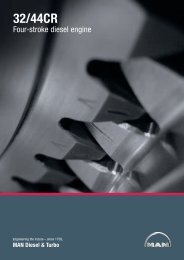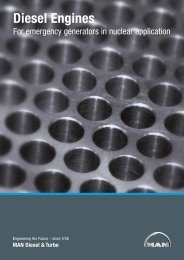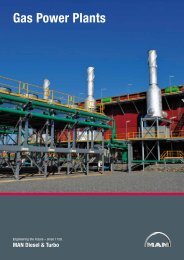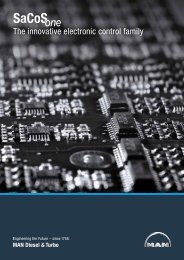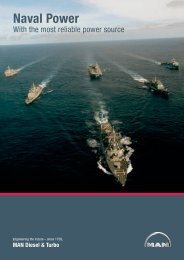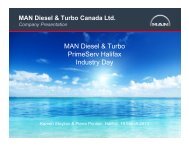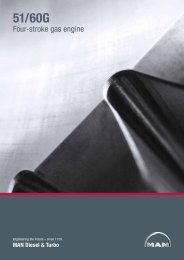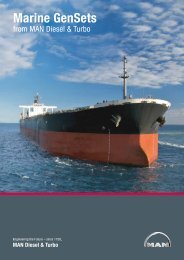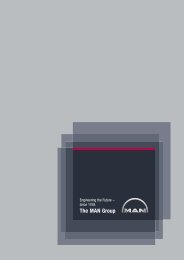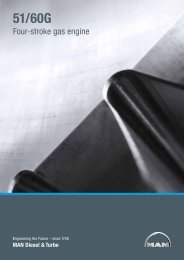Humid Air Motor - MAN Diesel & Turbo Canada
Humid Air Motor - MAN Diesel & Turbo Canada
Humid Air Motor - MAN Diesel & Turbo Canada
You also want an ePaper? Increase the reach of your titles
YUMPU automatically turns print PDFs into web optimized ePapers that Google loves.
<strong>Humid</strong> <strong>Air</strong> <strong>Motor</strong>Technology for green profits
Adding Ecology to EconomyHAMA widely acclaimed technology for reducing NO xpollution from diesel engines is the “<strong>Humid</strong> <strong>Air</strong> <strong>Motor</strong>”(HAM). This technology is able to reduce NO x formationby up to 65%. In the HAM system the turbochargedcombustion air is saturated with water vapour producedaboard the ship using sea water and engine heat.This lowers the temperature peaks in the combustionchamber, which are normally the main reason for NO xformation. HAM is characterised by extremely lowCutting NO x with humid airoperating costs due to sea water usage, decreasedlube oil consumption, very low maintenance costs anda very high availability factor.Consequently, following its philosophy of environmentallyfriendly engine development, <strong>MAN</strong> <strong>Diesel</strong> & <strong>Turbo</strong>now offers the HAM system. The company’s decisionto offer this technology is based, in particular, on theeconomics of the HAM system, which create favourableconditions for profitable engine operation.1816Throughout its history the diesel engine has always maintained its status asthe most efficient system for converting fuels into mechanical energy, and thissituation is expected to continue for the foreseeable future. This assertion appliesin all areas of application:the automotive sector, off-highway equipment, and inmarine propulsion and electrical power generation.In recent years, global and local regulations covering In general today, modern marine diesel engines areexhaust gas emissions from heavy duty medium capable of meeting the requirements of the first andspeed diesel engines have become progressively more second stages of the MARPOL 73/78 Annex VIstringent. They cover all applications i.e. power generationand propulsion systems on land and at sea. using only on-engine and in-cylinder modifications.regulations – commonly called IMO Tiers I and II –In particular, emissions of oxides of nitrogen (NO x ) have On the 1st january 2016, however, the NO x limitation ofbecome a major issue.IMO Tier III will come into force and is so stringent thatadditional devices will be needed (see figure 1).Since the 1980s, emissions reduction has been a majordevelopment aim at <strong>MAN</strong> <strong>Diesel</strong> & <strong>Turbo</strong> and has Moreover, there are already regional regulation suchresulted in the progressive introduction of exhaust gas as those in Norway and Sweden which rewardoptimised engines.every kg of NO x not emitted. In response to theseregulations, ship owners have an incentive to adoptNO x reduction systems on their fleets.NO x [g/kWh]141210864200 200 400 600 800 1000 1200 1400 1600 1800 2000 2200rpm [1/min]IMO Tier 1 IMO Tier 2 IMO Tier 3Figure 1: NO x limit curve of IMOTemperatureincreaseinside thecylinderwithout HAMNo HAMHAMNO x generating peakFigure 2: Cutting NO x with humid air – schematic heat release diagramTemperature increaseinside the cylinderwith HAMNO x forms exponentionallyover thistemperatureCrank angle2 <strong>Humid</strong> <strong>Air</strong> <strong>Motor</strong> – Technology for green profits <strong>Humid</strong> <strong>Air</strong> <strong>Motor</strong> – Technology for green profits 3
<strong>Humid</strong> <strong>Air</strong> <strong>Motor</strong> TechnologyH 2 O against NO xIt is well known that the cooling effect of water canprevent NO x formation during the combustion process.Well proven methods employing water to reduce NO xare fuel-water emulsification and humidification of inletair (HAM principle).When the water vapour is mixed with the compressedcharge air, two mechanisms can be identified:• Increase of the specific heat capacity of the mixture• Dilution of the charge air: water vapour replaces airHAM principleOver 90% of NO x formation results from combustiontemperature peaks. The principle of HAM is to humidifythe inlet air in order to lower these temperature peaks.The HAM system humidifier produces saturated air.The ability of water to decrease the formation ofNO x is exploited in the same way as with fuel wateremulsification, but the quantity of water added is muchhigher and the heat for water vaporisation is takenfrom the compressed air after the turbocharger orother engine-related heat sources.NO x -<strong>Humid</strong>ity Trend100100The quantity of water (in g/kg dry air) which can beinjected into the inlet air depends on the temperatureand the pressure of the mixture.As shown in the diagram in figure 3, when the air temperaturerises so does the quantity of water it is possible tovaporise.In this area HAM has an outstanding advantage, sinceit uses the heat of the engine to bring the saltwaterupto temperature. No external energy source is needed.In addition to the heat of the charge air after theturbocharger, in many applications heat from the enginecoolant and exhaust gases can be introduced into thecharge-air to increase its capacity to absorb moisture.8080With the HAM method a NO x reduction level of 40%is achieveable without using additional heating of theRelativ NO x Emission [%]60402006040200Charge <strong>Air</strong> Temperature [°C]intake air and a level of 65% when additional heat isintroduced from the engine coolant or exhaust gases.0 20 40 60 80 100 120X H2O [g/kg dry air]AdiabaticWith additional heatSaturation Line (2,5 bar)NOx-<strong>Humid</strong>ity TrendFigure 3: NO x -<strong>Humid</strong>ity Trend<strong>MAN</strong> B&W <strong>Diesel</strong>4 <strong>Humid</strong> <strong>Air</strong> <strong>Motor</strong> – Technology for green profits<strong>Humid</strong> <strong>Air</strong> <strong>Motor</strong> – Technology for green profits5
<strong>Humid</strong> <strong>Air</strong> <strong>Motor</strong> TechnologyReferencesHot compressed airCompressorTurbineProven in PracticeTo prove the theoretical results of HAM technology,field tests under real conditions were carried out.65<strong>Humid</strong>ifiedand cooled air<strong>Humid</strong>ificationtower47EngineMarineViking Line took the decision to equip all four enginesaboard its vessel “Mariella” with the HAM system. Thiscar ferry crosses daily between Helsinki and Stockholm.The main characteristics of the vessel are:• Length: 177 m, Breadth: 29 m, Weight: 37,800 t1Water Filling• 2200 passengers, 540 vehicles• 4 engines: 12 PC2-6.2 each rated 5,750 kWCatch Tank3 Heat exchangerat 500 rpm2Water circuitBleed-offFigure 4: Engine with HAM principleThe system was installed on main engine number onein July 1999 (all engines were subsequently equippedwith HAM) and since then it has been operating withseawater. The installation was carried out without interruptingvessel operation.How HAM worksThe functional principle of HAM is quite simple.Figure 4 illustrates the HAM Process:1 Filtered saltwater is pumped to the catch tankto replace evaporated and purged loop water.2 The HAM system itself cycles water in a loopbetween the catch tank and the <strong>Humid</strong>ification tower(“HAM vessel”)3 A heat exchanger between the catch tank and theHAM vessel heats the saltwater using an on-engineheat source.4 Three injection stages spray the heated saltwaterinto the charge air.567At the same time the compressed charge airfrom the exhaust turbocharger bypasses thecharge air cooler and is piped into the HAMvessel air inlet. Flowing through the HAM vessel,the charge air absorbs the water. Due to the highloop capacity of the water all particles (incl. salt)fall back into the catch tank and, over a certainsalinity level, are purged. Thus no salt from thesaltwater can enter the engine.To avoid tiny droplets reaching the combustionchamber, the humidified charge air passes througha high-performance mist catcher at the end of thehumidification tower.This humidification leads to saturated charge airwhich is fed into the engine.One of Viking Line’s requirements was to be ableto switch from the standard intake air system withcharge air cooler to HAM with the engine running. Thisrequirement was met by using butterfly valves.The ship-owner now considers that this conditionis no longer required since the charge air cooler isno longer necessary. In case of emergency, withoutHAM and without charge air cooling, it has beenverified that available power is still 50% to 60%.System installation in the engine room is illustrated infigure 5.<strong>MAN</strong> B&W <strong>Diesel</strong>Figure 5: HAM Installation on “Mariella”6 <strong>Humid</strong> <strong>Air</strong> <strong>Motor</strong> – Technology for green profits<strong>Humid</strong> <strong>Air</strong> <strong>Motor</strong> – Technology for green profits7
ReferencesField ExperienceSince July 1999 the systems have logged about100,000 operating hours without any major problems.The following list presents the results over that time:• Low operating & maintenance costs confirmed• Extended service intervals• No trace of water in lubeoil• Decreased lube oil consumption• No corrosion• Cleaner engine (deposits are “washed” away)• No need for turbocharger washing• Decrease of cylinder and valve temperaturesStationaryNO x decreaseNO x [ppm]1600140012001000800600400200040% 50% 60% 70% 80% 90% 100%LoadWith HAMWithout HAMMarine applicationsViking Line, M/S MariellaPassenger ferryS.E.M.T. Pielstick 4x12VPC 2.6 HFO5,7 MW per engine68% emissions reductionNyholmen AS M/V KvannoyPurser Trailer<strong>MAN</strong> 1X 16V28/32A MDO 3.9 MW62% emissions reductionPlant applicationsElectricité De France, Lucciana plantPower PlantS.E.M.T. Pielstick 1x 18VPC3 HFO12 MW65% emissions reduction<strong>Diesel</strong> United, Japan, Tohoku PlantPower PlantS.E.M.T. Pielstick 1X 12VPC4.2 HFO10.4 MW45% emissions reduction(60% beforemodifications of engineparameters)On Corsica, one PC3 engine (12 MW) was equippedwith HAM to test it under power plant conditions.Figure 6: NO x decrease on engine number 1 on board “Mariella”The following data are available on this configuration:• Specific fresh water consumption: 410 g/kWhThe following results were confirmed during the test:• NOx = – 65% is confirmed• 650 mg/Nm 3 CO limit8 <strong>Humid</strong> <strong>Air</strong> <strong>Motor</strong> – Technology for green profits <strong>Humid</strong> <strong>Air</strong> <strong>Motor</strong> – Technology for green profits 9
ConclusionTo meet the challenge of reducing oxides of nitrogenduring diesel engine combustion, the HAM system isan efficient solution with the following advantages:Efficient NO x reductionThe targeted NO x reduction of 65% was confirmedduring HAM usage on the car ferry “Mariella” and apower station on Corsica.Very low operating costsSeawater may be used as the consumable for theHAM system, meaning operating costs are very low.The use of an additive to prevent calcium deposit doesnot significantly increase operating costs. The heatto vaporise the water can be taken from on-enginesources i.e. engine coolant and exhaust gases, withoutaffecting the ship’s overall energy recovery levels. Evenwith no additional input of heat, a NO x reduction levelof 40% is achieved at nominal load.Best practice to fulfill regulations from an economicstandpointAll three case studies showed that under the specificconditions of existing regulations, and taking accountof the balance of investment to operating costs, HAMalways demonstrated extremely short amortisationperiods.Engine operation optimisationAddition of water vapour to the charge air has abeneficial effect:• Exhaust gas temperatures and valve temperaturesare lower, leading to a decrease in thermal loading.Simple operationThe use of HAM is simple as shown by experienceon the “Mariella”:• Simultaneous start for both HAM and engine.• 15 minutes before stopping the engine: engine atidle speed and water circulation shut off in order todry the air system.System reliabilityThe system is intrinsically self-controlled without anyneed of a load-related control loop. The system isstable and responsive.• Longevity: Even after 100,000 hours of operation,HAM has demonstrated consistently high effectivenessin NO x reduction.• Stable: No abrupt changes in engine operatingparameters if water circulation is shut-off.• Responsive: favourable response to load variations.The HAM system is thus an economically and ecologicallyviable way to effectively reduce NO x whileoptimising engine operation.10 <strong>Humid</strong> <strong>Air</strong> <strong>Motor</strong> – Technology for green profits <strong>Humid</strong> <strong>Air</strong> <strong>Motor</strong> – Technology for green profits 11
<strong>MAN</strong> PrimeServ FranceBP 42744615 Saint-Nazaire Cedex, FrancePhone +33 2 40 90 65 00primeserv-fr@mandieselturbo.com<strong>MAN</strong> PrimeServ FrederikshavnNiels Juels Vej 159900 Frederikshavn, DenmarkPhone +45 9620 4100primeserv-frh@mandieselturbo.com<strong>MAN</strong> PrimeServ HolebyH. Christoffersensvej 64960 Holeby, DenmarkPhone +45 54 69 31 03primeserv-hol@mandieselturbo.com<strong>MAN</strong> PrimeServ UK1 Mirrlees DriveStockport, Cheshire, SK7 5BPUnited KingdomPhone +44 161 483 1000primeserv-uk@mandiesel.com<strong>MAN</strong> PrimeServ AugsburgStadtbachstraße 186153 Augsburg, GermanyPhone +49 821 322-0primeserv-aug@mandieselturbo.comindividual projects, the relevant data may be subject to changes and will be assessed and determined individually for each project. This will depend on the particular characteristics ofeach individual project, especially specific site and operational conditions · Copyright © <strong>MAN</strong> <strong>Diesel</strong> & <strong>Turbo</strong> · D2366482EN Printed in Germany GMC-AUG-04112 Product-ID DSTN0014All data provided in this document is non-binding. This data serves informational purposes only and is especially not guaranteed in any way. Depending on the subsequent specificwww.mandieselturbo.com<strong>MAN</strong> PrimeServ – a service brand of <strong>MAN</strong> <strong>Diesel</strong> & <strong>Turbo</strong>



